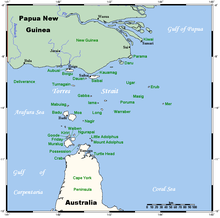Kaurareg People
| Kaurareg people | |
|---|---|
| aka: Kaurarega, Kowrarega, Kauralaig, Kauraleg, Kororega, Korariga, Kauralaigna, Malulaig, Muralug (name of part of Prince of Wales Island), Kokkaiya (group on Yorke Island), Alkaiyana (people of "inside" Turtle Islands), Koiyana (people of "outside" islands), and Muralag (AIATSIS), nd (SIL) | |

A map of the Torres Strait Islands, with the Kaurareg traditional country located in the middle band of islands
|
|
| Hierarchy | |
| Language family: | Pama–Nyungan |
| Language branch: | Mabuiag |
| Language group: | Western Mabuiag |
| Group dialects: | Kalaw Lagaw Ya |
| Area | |
| Bioregion: | Cape York Peninsula |
| Location: | Torres Strait Islands, Far North Queensland, Australia |
| Coordinates: | 10°41′02″S 142°11′06″E / 10.684°S 142.185°ECoordinates: 10°41′02″S 142°11′06″E / 10.684°S 142.185°E |
| Islands: |
|
Kaurareg (alt. Kauraraiga) is the name for an indigenous Australian Torres Strait Island people. Historically they were, lower western islanders, based primarily on Muralag. Commanding an impressive outrigger technology they also conducted a nomadic life throughout the straits, fishing and trading with other Torres island groups, and venturing down to the Australian mainland of Cape York Peninsula, with several of whose tribes they held ceremonial, marriage and trading alliances. Subject to reprisals after being blamed for an incident in which a Western schooner and its crew were destroyed, their numbers rapidly diminished with the onset of white colonization and administration. After World War II, descendants of the Kaurareg began to return to their traditional islands, and lay claim to native title over several of them.
The Kaurareg speak a dialect of Kalaw Lagaw Ya, an isolate in the Pama–Nyungan family,.
The Kaurareg lie in the lower Western island group among the 5 basic ethno-culturally distinct groups that constituted the traditional world of the Torres Strait Islanders, the others being the Saibailgal, Dœwanalgal and Bœigulgal (Top West islanders), the Maluigal (Mid-West islanders), Kulkalgal (Central Islanders) and Meriam Le (Eastern Islanders). Though internecine conflict was chronic in the region, it did not disrupt the dynamic interlocking trade system that linked all in a far-flung exchange system, whose goods extended beyond the islands to facilitate the flow of goods between New Guinea and the Cape York Peninsula. The Kaurereg and the Mua traded bu (trumpet shells), alup (bailer shells) and wap(dugong harpoons) for Papuan canoes, cassowary bone-tipped daggers and arrows, and bamboo knives for beheading enemies (upi).
The Kaurareg in particular had close links with the tribes of northern Cape York, which was home to a number of Aboriginal groups. These were the Gudang whose territory extended from Cape York to Fly Point; the Gumakudin whose land was to the southwest of Cape York; the Unduyamo who were in the northern part of Newcastle Bay, and the Yadhaigana whose country went from Jackey Jackey Creek to Escape River.A.C.Haddon, surveying the field reports of the ethnography to date, esp. the narratives collected by Gunnar Landtman, classified the Kaurareg as descendants of the ancient Hiamu people of the island of Daru off the southern Papuan coast. These Hiamu in turn, according to some legends, had come from Iama in the Bourke Isles. The Hiamu, it was said, were repeatedly worsted in encounters with Papuan groups, and abandoned Daru and moved to Muralag.
...
Wikipedia
